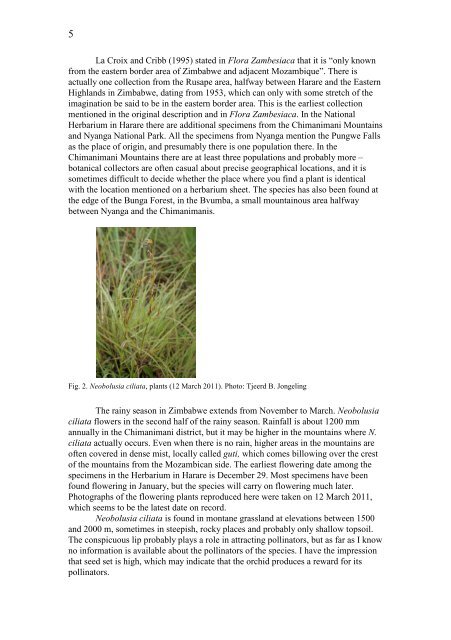Orchid Research Newsletter No. 29 - Royal Botanic Gardens, Kew
Orchid Research Newsletter No. 29 - Royal Botanic Gardens, Kew
Orchid Research Newsletter No. 29 - Royal Botanic Gardens, Kew
You also want an ePaper? Increase the reach of your titles
YUMPU automatically turns print PDFs into web optimized ePapers that Google loves.
5<br />
La Croix and Cribb (1995) stated in Flora Zambesiaca that it is “only known<br />
from the eastern border area of Zimbabwe and adjacent Mozambique”. There is<br />
actually one collection from the Rusape area, halfway between Harare and the Eastern<br />
Highlands in Zimbabwe, dating from 1953, which can only with some stretch of the<br />
imagination be said to be in the eastern border area. This is the earliest collection<br />
mentioned in the original description and in Flora Zambesiaca. In the National<br />
Herbarium in Harare there are additional specimens from the Chimanimani Mountains<br />
and Nyanga National Park. All the specimens from Nyanga mention the Pungwe Falls<br />
as the place of origin, and presumably there is one population there. In the<br />
Chimanimani Mountains there are at least three populations and probably more –<br />
botanical collectors are often casual about precise geographical locations, and it is<br />
sometimes difficult to decide whether the place where you find a plant is identical<br />
with the location mentioned on a herbarium sheet. The species has also been found at<br />
the edge of the Bunga Forest, in the Bvumba, a small mountainous area halfway<br />
between Nyanga and the Chimanimanis.<br />
Fig. 2. Neobolusia ciliata, plants (12 March 2011). Photo: Tjeerd B. Jongeling<br />
The rainy season in Zimbabwe extends from <strong>No</strong>vember to March. Neobolusia<br />
ciliata flowers in the second half of the rainy season. Rainfall is about 1200 mm<br />
annually in the Chimanimani district, but it may be higher in the mountains where N.<br />
ciliata actually occurs. Even when there is no rain, higher areas in the mountains are<br />
often covered in dense mist, locally called guti, which comes billowing over the crest<br />
of the mountains from the Mozambican side. The earliest flowering date among the<br />
specimens in the Herbarium in Harare is December <strong>29</strong>. Most specimens have been<br />
found flowering in January, but the species will carry on flowering much later.<br />
Photographs of the flowering plants reproduced here were taken on 12 March 2011,<br />
which seems to be the latest date on record.<br />
Neobolusia ciliata is found in montane grassland at elevations between 1500<br />
and 2000 m, sometimes in steepish, rocky places and probably only shallow topsoil.<br />
The conspicuous lip probably plays a role in attracting pollinators, but as far as I know<br />
no information is available about the pollinators of the species. I have the impression<br />
that seed set is high, which may indicate that the orchid produces a reward for its<br />
pollinators.

















